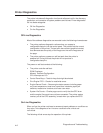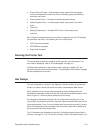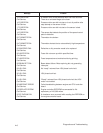
4–2
Diagnostics and Troubleshooting
Printer Diagnostics
The printer includes self-diagnostic circuits and software to aid in the discovery,
prevention, and correction of system problems and failures. Printer diagnostics
fall into these categories:
• Off-line Diagnostics
• On-line Diagnostics
Off-Line Diagnostics
Most of the software diagnostics are executed under the following circumstances:
• The printer performs diagnostic routines when you request a
configuration/test print via the control panel. The printout lists the current
configuration of the printer. The test print also contains graphical content
that demonstrates the quality of the image over the entire image area of
the page.
• The printer performs a power-on self test each time the printer is
powered on. During this test the printer will not produce a
configuration/test print.
The power-on self test consists of the following:
• The printer controller self test:
ROM Checksum
Memory Test/Auto Configuration
CPU Interrupts and I/O
• Control Panel Keys – Tests for keys that might be shorted.
• Print Engine FIFO – Checks for read/write errors.
• Engine Sensor Check – Scans engine status sensors including paper
out, fuser temperature, toner level, cover/door interlocks, paper jam
switches, waste toner container, and fuser cam motor.
• System Life Counts – Checks page count to verify that the OPC drum
and the engine life counts have not been exceeded. The printer system
counter, part of the OPC assembly, is reset when you replace the OPC.
On-Line Diagnostics
When on line, the printer continues to sense and report problems or conditions as
they arise. Two categories of on–line error conditions exist: critical and
non-critical.
The following critical errors stop the operation of the printer:


















